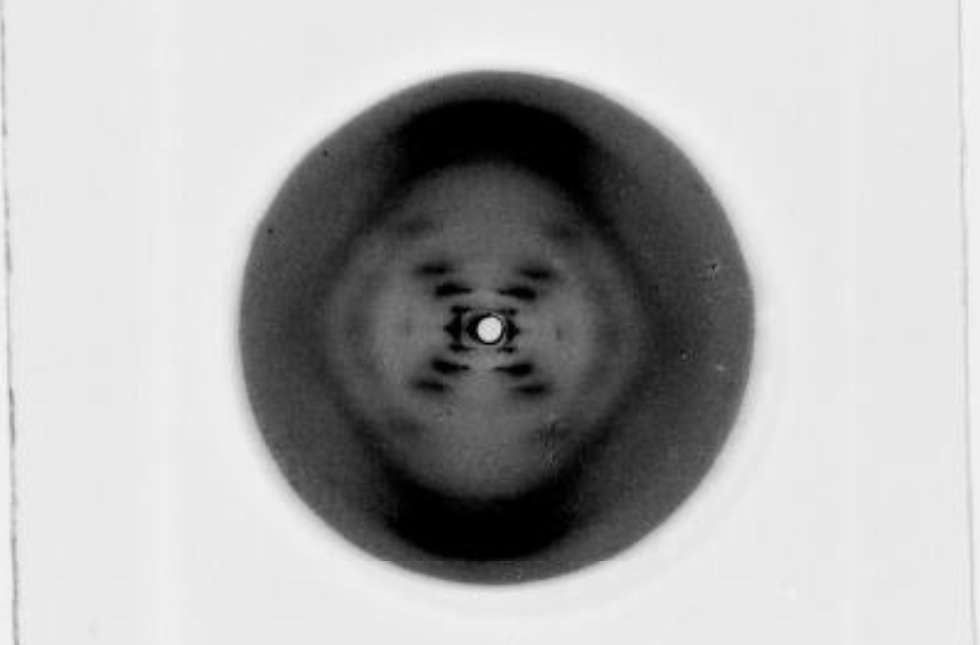How 'Photo 51' Changed the World

Each Monday, this column turns a page in history to explore the discoveries, events and people that continue to affect the history being made today.
There are many historical snapshots that have captured popular imagination, from the flag-raising at Iwo Jima to a wild-haired Albert Einstein sticking out his tongue, but few pictures are both so important and so unrecognizable as the one scientists call Photo 51.
Captured by English chemist Rosalind Franklin in 1952, Photo 51 is a fuzzy X -ray depicting a strand of DNA extracted from human calf tissue — the clearest shot of life's building blocks ever seen up to that point, and the first one that seemed to prove once and for all the double-helix structure of DNA.
Fatefully, a colleague would hand Photo 51 over to James Watson and Francis Crick before Franklin could publish her results. Watson and Crick, fellow scientists also working on DNA, immediately recognized the importance of the picture's contents and, not long after, published their famous Nature journal article in 1953, heralding a new era in genetics.
X marks the spot
With all the frenzied advancement in the world of genetics in the early 1950s, it was two pairs of scientists working just 50 miles apart — Watson and Crick at Cambridge and Franklin and Maurice Wilkins at King's College in London — who managed to close in on the Holy Grail of DNA science at precisely the same time.
By that time, scientists were using the term "gene" to describe the smallest unit of genetic information that was passed from one generation to the next, but they did not know what the material actually looked like.
Get the world’s most fascinating discoveries delivered straight to your inbox.
Watson and Crick spent the better part of 1951 investigating the structure of DNA. They did no genuine DNA experiments of their own, instead creating cardboard stick-and-ball models with each new piece of information they gathered from the vast amounts of data that was continuously being released in the field.
Some of that data belonged to Franklin. Working in the lab alongside Wilkins in 1952, Franklin had taken a startling, high-resolution photograph of a piece of DNA using X -ray crystallography, a technique whereby X -rays are shone on a crystalline structure (in this case, the DNA protein), to create a scattered reflection pattern on film.
To the naked eye the photo looked merely like an X diced up into bits, but to Franklin it confirmed what she and all the other genetics suspected: DNA was a double-helix.
Whether out of competitive animosity or disrespect — female scientists still did not have the right to eat in the dining rooms at King's College, after all — Wilkins took Photo 51 without her knowledge to Watson, who immediately recognized its significance.
With the double-helix structure established, other pieces of the DNA puzzle fell into place. When they'd finally unraveled the complicated relationships between the four types of protein "rungs" (A, T, C and G) and their twin sugar-phosphate backbones in 1953, Watson and Crick published their landmark findings.
We're all a bunch of corkscrews
Despite having no personal experiments included in the research and a drawing by Crick's wife, Odile, to illustrate their structure, Watson and Crick's findings would go on to revolutionize the field of genetics.
Knowing how the corkscrew-like DNA strand was configured, scientists could determine just how genes, those building-blocks of life, actually did their job.
The most important corresponding leap forward concerned copying. Unzipping all the A-T and C-G pairs of a double-helix straight down the middle makes for a neat and tidy way for the body to reproduce its own cells, Crick suggested in a second Nature article, since the two strands left behind served as templates for the complementary new chains. His theories on how genetic information was transmitted were validated by experiments in the late 1950s.
Rosalind Franklin would have come to the same conclusions before Watson and Crick, some historians and biologists such as California State University's Lynne Osman Elkin think, had Photo 51 not made its ways into James Watson's hands.
Watson and Crick, along with Wilkins, went on to win the 1962 Nobel Prize for their work. Franklin died four years earlier and the award is never awarded posthumously, so it is uncertain whether she would have been included with that group.
- See Photo 51
- Video - The Next Step in DNA Art
- Archive of 'Changed the World' Columns



